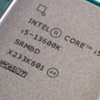Intel processor family
13th Generation Core processors - Raptor Lake
Raptor Lake is Intel's codename for the 13th-generation Intel Core CPUs, which will be built on a hybrid architecture with Gracemont power-efficient cores. Raptor Lake, like Alder Lake, will be manufactured utilising Intel's Intel 7 technology. Raptor Lake will have up to 24 cores (8 performance cores + 16 efficiency cores) and 32 threads, and will be socket compatible with Alder Lake computers (LGA 1700). Standard features of Raptor Lake desktop CPUs:
- Socket: LGA 1700.
- All the CPUs support up to 128 GB of DDR4-3200 or DDR5-5600 RAM in dual-channel mode.
- All the CPUs support 16x PCI Express Gen 5 and 4x PCI Express Gen 4 lanes, but support may vary depending on motherboard and chipsets.
- Some models feature integrated UHD Graphics 770 GPU with 32 EUs and base frequency of 300 MHz.
- By default Raptor Lake CPUs are configured to run at Turbo Power at all times and Base Power is only guaranteed when P-Cores/E-cores do not exceed the base clock rate.
- Max Turbo Power: the maximum sustained (> 1 s) power dissipation of the processor as limited by current and/or temperature controls. Instantaneous power may exceed Maximum Turbo Power for short durations (≤ 10 ms). Maximum Turbo Power is configurable by system vendor and can be system specific.
- K model CPUs feature ECC memory support only when paired with a motherboard based on the W680 chipset. Other SKUs do not support ECC memory at all.
Alder Lake but better?
Raptor Lake is an improved version of Alder Lake, employing the same node and hybrid architecture. We will go over that architecture in more detail later, but in terms of specifications, Intel is focused on more significant core counts and clock rates, as well as more cache, to compete with gaming CPUs like the Ryzen 7 5800X3D and Ryzen Series 7000 Whilst core counts are increasing, Intel is not adding more P-cores, instead deciding to increase the E-core count. This may be useful for heavy multitasking. However, E-cores do not enable Hyperthreading. For example, the Core i9-13900K, for example, has 24 cores but only 32 total threads. Clock rates have also increased, with the top Core i9-13900K running at 5.8GHz on a single core. The most noticeable deviation from Alder Lake is its cache. Raptor Lake has double the L2 cache, which might aid in cache-sensitive games. Power constraints remain considerable, as they were on 12th-generation CPUs. This time around, Intel is pushing the limits a little farther, with a 12W bump on the i9 and i7 and a 31W rise on the i5. Intel's 12th-generation CPUs already ran hot, so the additional power and core count are unlikely to make a significant difference. We will have to wait till the chips arrive to determine whether that affects performance.
Looking closely at the architecture, you can see how similar Raptor Lake is to Alder Lake. 13th-generation CPUs have the same Intel 7 manufacturing process and a hybrid design. To improve multitasking performance while minimising power and thermal demands, cores are divided into performance (P) cores and efficient (E) cores. Intel stuck with the same Gracemont E-cores that debuted in Alder Lake, only increasing their number on the chip. However, Intel has verified that the P-cores feature the new Raptor Cove microarchitecture. According to Intel, the revised architecture has "enhanced speed routes."
Intel claims it improved core voltage as frequency climbed, allowing Raptor Lake CPUs to run at greater clock rates than Alder Lake rivals. The new architecture also has 2MB of L2 cache per core, double the amount available on Alder Lake. Intel is adopting a bigger die to fit more E-cores and their cache to accommodate more power. The numerous cores and their varying designs are linked by a broader computing fabric that spans the die. The new fabric enables higher clock rates of up to 900MHz than the previous generation and adds up to 36MB of shared L2 cache. Intel's bulk of performance gains is still due to frequency and thread count. Along with hardware enhancements, Intel also mentioned it is working to optimise features such as Intel Thread Director, which helps distribute workloads to the most appropriate core.


